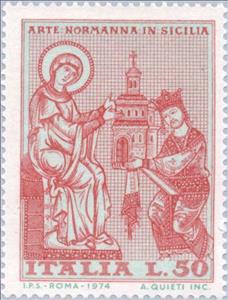Stamp: King William offering the crown to the Virgin (Italy 1974)
King William offering the crown to the Virgin (Italy 1974)
16 March (Italy ) within release Norman Art in Sicily goes into circulation Stamp King William offering the crown to the Virgin face value 50 Italian lira
| Stamp King William offering the crown to the Virgin in catalogues | |
|---|---|
| Michel: | Mi:IT 1436 |
| Stamp Number: | Sn:IT 1139 |
| Yvert et Tellier: | Yt:IT 1169 |
| Stanley Gibbons: | Sg:IT 1386 |
| Unificato: | Un:IT 1243 |
Stamp is vertical format.
Also in the issue Norman Art in Sicily:
- Stamp - Christ crowning King Roger face value 20;
- Stamp - King William offering the crown to the Virgin face value 50;
Stamp King William offering the crown to the Virgin it reflects the thematic directions:
King is the title given to a male monarch in a variety of contexts. The female equivalent is queen regnant (while the title of queen on its own usually refers to the consort of a king). In the context of prehistory, antiquity and contemporary indigenous peoples, the title may refer to tribal kingship. Germanic kingship is cognate with Indo-European traditions of tribal rulership (c.f. Indic rājan, Gothic reiks, and Old Irish rí, etc.) In the context of classical antiquity, king may translate Latin rex or either Greek archon or basileus. In classical European feudalism, the title of king as the ruler of a kingdom is understood as the highest rank in the feudal order, potentially subject, at least nominally, only to an emperor (harking back to the client kings of the Roman Empire). In a modern context, the title may refer to the ruler of one of a number of modern monarchies (either absolute or constitutional). The title of king is used alongside other titles for monarchs, in the West prince, emperor, archduke, duke or grand duke, in the Middle East sultan or emir; etc. Kings, like other royalty, tend to wear purple because purple was an expensive color to wear in the past.
A church building, often simply called a church, is a building used for Christian religious activities, particularly worship services. The term in its architectural sense is most often used by Christians to refer to their religious buildings, but it is sometimes used (by analogy) for buildings of other religions. In traditional Christian architecture, the church is often arranged in the shape of a Christian cross. When viewed from plan view the longest part of a cross is represented by the aisle and the junction of the cross is located at the altar area. Towers or domes are often added with the intention of directing the eye of the viewer towards the heavens and inspiring church visitors. Modern church buildings have a variety of architectural styles and layouts; many buildings that were designed for other purposes have now been converted for church use; and, similarly, many original church buildings have been put to other uses. The earliest identified Christian church was a house church founded between 233 and 256. During the 11th through 14th centuries, a wave of building of cathedrals and smaller parish churches occurred across Western Europe. A cathedral is a church, usually Roman Catholic, Anglican, Oriental Orthodox or Eastern Orthodox, housing the seat of a bishop.


